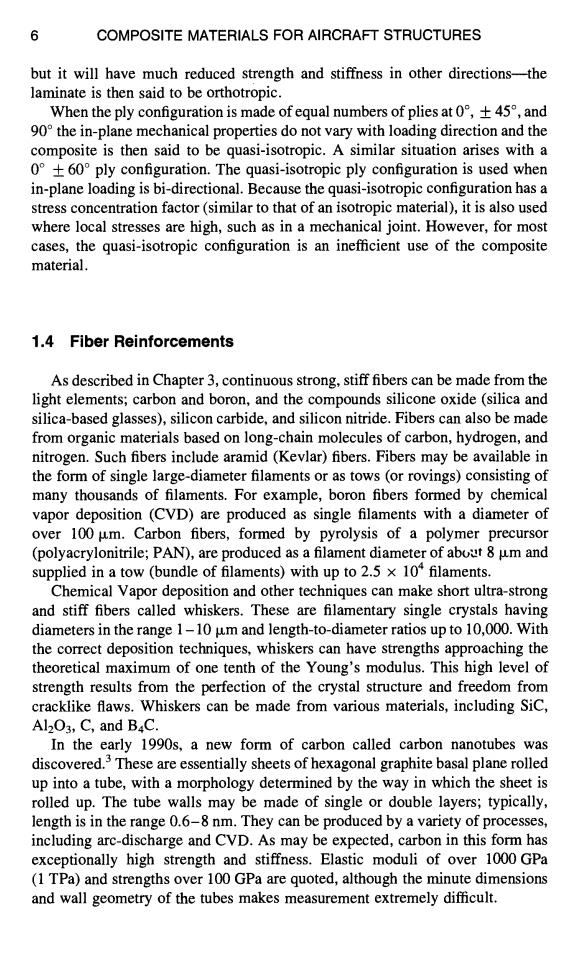正在加载图片...

6 COMPOSITE MATERIALS FOR AIRCRAFT STRUCTURES but it will have much reduced strength and stiffness in other directions-the laminate is then said to be orthotropic. When the ply configuration is made of equal numbers of plies at0°,±45°,and 90the in-plane mechanical properties do not vary with loading direction and the composite is then said to be quasi-isotropic.A similar situation arises with a 060 ply configuration.The quasi-isotropic ply configuration is used when in-plane loading is bi-directional.Because the quasi-isotropic configuration has a stress concentration factor(similar to that of an isotropic material),it is also used where local stresses are high,such as in a mechanical joint.However,for most cases,the quasi-isotropic configuration is an inefficient use of the composite material. 1.4 Fiber Reinforcements As described in Chapter 3,continuous strong,stiff fibers can be made from the light elements;carbon and boron,and the compounds silicone oxide(silica and silica-based glasses),silicon carbide,and silicon nitride.Fibers can also be made from organic materials based on long-chain molecules of carbon,hydrogen,and nitrogen.Such fibers include aramid (Kevlar)fibers.Fibers may be available in the form of single large-diameter filaments or as tows (or rovings)consisting of many thousands of filaments.For example,boron fibers formed by chemical vapor deposition (CVD)are produced as single filaments with a diameter of over 100 um.Carbon fibers,formed by pyrolysis of a polymer precursor (polyacrylonitrile;PAN),are produced as a filament diameter of about 8 um and supplied in a tow (bundle of filaments)with up to 2.5 x 10 filaments. Chemical Vapor deposition and other techniques can make short ultra-strong and stiff fibers called whiskers.These are filamentary single crystals having diameters in the range 1-10 um and length-to-diameter ratios up to 10,000.With the correct deposition techniques,whiskers can have strengths approaching the theoretical maximum of one tenth of the Young's modulus.This high level of strength results from the perfection of the crystal structure and freedom from cracklike flaws.Whiskers can be made from various materials,including SiC, Al2O3,C,and B4C. In the early 1990s,a new form of carbon called carbon nanotubes was discovered.These are essentially sheets of hexagonal graphite basal plane rolled up into a tube,with a morphology determined by the way in which the sheet is rolled up.The tube walls may be made of single or double layers;typically, length is in the range 0.6-8 nm.They can be produced by a variety of processes, including arc-discharge and CVD.As may be expected,carbon in this form has exceptionally high strength and stiffness.Elastic moduli of over 1000 GPa (1 TPa)and strengths over 100 GPa are quoted,although the minute dimensions and wall geometry of the tubes makes measurement extremely difficult.6 COMPOSITE MATERIALS FOR AIRCRAFT STRUCTURES but it will have much reduced strength and stiffness in other directions--the laminate is then said to be orthotropic. When the ply configuration is made of equal numbers of plies at 0 °, ___ 45 °, and 90 ° the in-plane mechanical properties do not vary with loading direction and the composite is then said to be quasi-isotropic. A similar situation arises with a 0 ° +__ 60 ° ply configuration. The quasi-isotropic ply configuration is used when in-plane loading is bi-directional. Because the quasi-isotropic configuration has a stress concentration factor (similar to that of an isotropic material), it is also used where local stresses are high, such as in a mechanical joint. However, for most cases, the quasi-isotropic configuration is an inefficient use of the composite material. 1.4 Fiber Reinforcements As described in Chapter 3, continuous strong, stiff fibers can be made from the light elements; carbon and boron, and the compounds silicone oxide (silica and silica-based glasses), silicon carbide, and silicon nitride. Fibers can also be made from organic materials based on long-chain molecules of carbon, hydrogen, and nitrogen. Such fibers include aramid (Kevlar) fibers. Fibers may be available in the form of single large-diameter filaments or as tows (or rovings) consisting of many thousands of filaments. For example, boron fibers formed by chemical vapor deposition (CVD) are produced as single filaments with a diameter of over 100 p~m. Carbon fibers, formed by pyrolysis of a polymer precursor (polyacrylonitrile; PAN), are produced as a filament diameter of about 8 Ixm and supplied in a tow (bundle of filaments) with up to 2.5 x 10 4 filaments. Chemical Vapor deposition and other techniques can make short ultra-strong and stiff fibers called whiskers. These are filamentary single crystals having diameters in the range 1 - 10 Izm and length-to-diameter ratios up to 10,000. With the correct deposition techniques, whiskers can have strengths approaching the theoretical maximum of one tenth of the Young's modulus. This high level of strength results from the perfection of the crystal structure and freedom from cracklike flaws. Whiskers can be made from various materials, including SiC, A1203, C, and B4C. In the early 1990s, a new form of carbon called carbon nanotubes was discovered. 3 These are essentially sheets of hexagonal graphite basal plane rolled up into a tube, with a morphology determined by the way in which the sheet is rolled up. The tube walls may be made of single or double layers; typically, length is in the range 0.6-8 nm. They can be produced by a variety of processes, including arc-discharge and CVD. As may be expected, carbon in this form has exceptionally high strength and stiffness. Elastic moduli of over 1000 GPa (1 TPa) and strengths over 100 GPa are quoted, although the minute dimensions and wall geometry of the tubes makes measurement extremely difficult